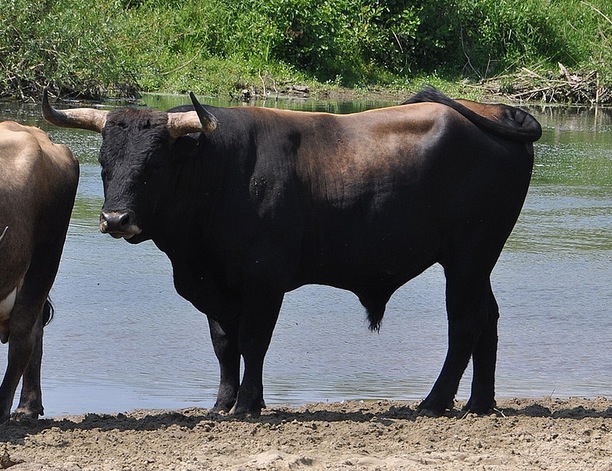Urus
The iconic urus is the massive black bull with enormous horns and a lightning temper. Urus are famously powerful and aggressive, prone to attacking with little-to-no warning if provoked and are more than capable of killing an adult yutaaq.
Basic Information
Ecology and Habitats
Urus live in the wetlands and river valleys of the taiga and tundra of south Ewas. They eat grasses, flowers, shrubs and woody plants, maintaining open areas and floodplains through grazing, but rarely venture deeply into the boral forest.
Adult urus have no predators apart from sapient species, but calves may be predated by skuh, bears, and rock lions.
Additional Information
Social Structure
Urus live in single-sex herds of up to 30 indviduals and only come together in the autumn for breeding. Although herds do not maintain territories, they tend to avoid each other outside the breeding season. Consequentially, clashes between herds are rare, but in-group fighting to establish dominance can be intense and fatalities are common.
Establishing dominance
In herds, adults have dominance over juveniles and maintain it by threat displays (roaring and bellowing, pawing at the ground, and mock rushes). If a juvenile or subordibnate adult challenges the dominant adult or fails to give way in timely manner, they two will lock horns and attempt to wrestle the other to the ground. The weaker of the two may be thrown to the ground, where they risk being trampled, or attempt to disengage, whereupon the other will give chase and attempt to gore them. In cow-herds, dominance is largely settled by late summer, before breeding begins, and conflict between pregnant females is rare. The pace and direction or travel, and resting sites are dictated by the most dominant pregnant or nursing individual. Fights for dominance between bulls may happen year-round.Domestication
The lineage of the domesticated cow can be traced back to a handful of captured urus in the Third Age. Efforts to breed out the urus' aggression have been largely successful (with the notable exception of the Kirh nyübiik).
Geographic Origin and Distribution
Southern Ewas, including the Kijarlean empire, Kanmaa, Bjeria, and Kirh
Civilization and Culture
Culture and Cultural Heritage
The tuletary deity of Bjeria appears as a bull urus, and the iconic horns are the emblem of the Bjerian imperial family. Only members of the imperial family are permitted to hunt urus within Bjeria.
Herds of semi-wild urus are kept in parkland near Tuuha, and animals from these are sacrificed to Bjeria and the meat distributed among the poor on Mōdraniht.
Scientific Name
fradhord astirmudde
Lifespan
30
Average Height
135-155cm (cows)
155–180 cm (bulls)
Average Weight
700kg (cows)
1,500 kg (bulls)
Body Tint, Colouring and Marking
Bulls are black with a grey eel-stripe, cows are red-brown. Both have horns.
Geographic Distribution
Related Organizations
Remove these ads. Join the Worldbuilders Guild




Comments